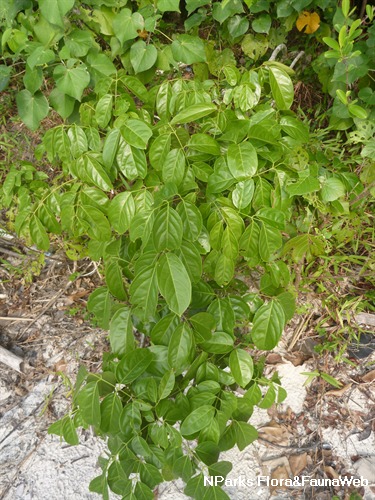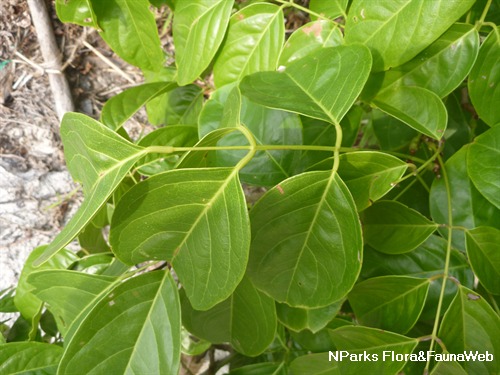
Back
Aganope heptaphylla (L.) Polhill
| Family Name: | Fabaceae (Leguminosae) |
| Synonyms: | Derris heptaphylla (L.) Merr., Derris sinuata Benth. ex Thwaites |
Name
Classifications and Characteristics
| Plant Division | Angiosperms (Flowering Seed Plants) (Dicotyledon) |
|---|---|
| Plant Growth Form | Climber, Shrub |
| Lifespan (in Singapore) | Perennial |
| Mode of Nutrition | Autotrophic |
| Plant Shape | Irregular |
Biogeography
| Native Distribution | Sri Lanka, India, Indochina, Thailand, Peninsular Malaysia, and Singapore |
|---|---|
| Native Habitat | Terrestrial (Coastal Forest), Shoreline (Mangrove Forest, Sandy Beach) |
| Preferred Climate Zone | Tropical, Sub-Tropical / Monsoonal |
| Local Conservation Status | Native to Singapore (Critically Endangered (CR)) |
Description and Ethnobotany
| Growth Form | It is a shrub, or sometimes taking the form of a woody climber. |
|---|---|
| Foliage | Its spirally arranged, stalked, imparipinnate leaves have 3, 5, 7 or 9 leathery leaflets whose blades are egg-shaped to egg-shaped-oblong, hairless, and 10–12.5 by 5–7.5 cm. |
| Flowers | Its flowers grow on terminal flowering shoots that are 15–30 cm long. The flowers are greenish and 1.5 cm long. |
| Fruit | Its fruits are strap-shaped pods, about 10–20.5 by 3.8 cm, with wavy margins. |
| Habitat | It grows on tidal rivers, coastal forests, and sandy beaches. |
| Associated Fauna | Its flowers are insect-pollinated. |
| Cultivation | It can be propagated by seed. |
| Etymology | Greek aganos, kindly, gently, the reference to which is unknown; Greek hepta, seven; Greek phylla, leaf, referring to the imparipinnate leaves of this plant which may have seven leaflets |
| Ethnobotanical Uses | Edible Plant Parts : Edible Leaves Food (Fruit or Vegetable): Its young leaves are edible and have medicinal properties. Others: Its bark is a source of tannin. |
Landscaping Features
| Landscaping | It is suitable for planting in parks. |
|---|---|
| Desirable Plant Features | Ornamental Flowers |
| Landscape Uses | Parks & Gardens, Beachfront / Shoreline |
Fauna, Pollination and Dispersal
| Pollination Method(s) | Biotic (Fauna) |
|---|---|
| Seed or Spore Dispersal | Abiotic |
Plant Care and Propagation
| Light Preference | Full Sun |
|---|---|
| Water Preference | Moderate Water |
| Rootzone Tolerance | Well-Drained Soils, Saline Soils / Salt Spray |
| Propagation Method | Seed |
Foliar
| Foliage Retention | Evergreen |
|---|---|
| Mature Foliage Colour(s) | Green |
| Mature Foliage Texture(s) | Leathery |
| Foliar Type | Compound (Odd-Pinnate) |
| Foliar Arrangement Along Stem | Alternate |
| Foliar Attachment to Stem | Petiolate |
| Foliar Shape(s) | Non-Palm Foliage (Ovate, Oblong) |
| Foliar Venation | Pinnate / Net |
| Foliar Margin | Entire |
Floral (Angiosperm)
| Flower & Plant Sexuality | Bisexual Flowers |
| Flower Colour(s) | Green - Light Green, White |
|---|---|
| Flower Grouping | Cluster / Inflorescence |
| Flower Location | Axillary |
| Individual Flower Shape | Papilionaceous / Pea-shaped |
Fruit, Seed and Spore
| Mature Fruit Colour(s) | Brown |
|---|---|
| Fruit Classification | Simple Fruit |
| Fruit Type | Dehiscent Dry Fruit , Legume / Pod |
Image Repository
Others
| Master ID | 32131 |
|---|---|
| Species ID | 6537 |
| Flora Disclaimer | The information in this website has been compiled from reliable sources, such as reference works on medicinal plants. It is not a substitute for medical advice or treatment and NParks does not purport to provide any medical advice. Readers should always consult his/her physician before using or consuming a plant for medicinal purposes. |



